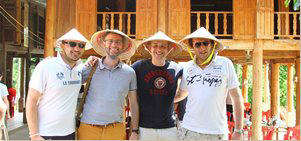Just outside of Hanoi are many great sites to see and experience. From pagodas to ancient villages to pottery workshops, spending a day outside of Hanoi is a great way to learn about daily life in Vietnam.
Bat Trang, ceramic art destination
The art of pottery is one of the oldest traditions of Vietnam and Bat Trang, one of the most famous ceramic villages is located just 10km from Hanoi. Literally translated as “village of bowls,” Bat Trang boasts a pottery making heritage that dates back over 600 years, making it one of the oldest villages to practice the craft. Bat Trang offers visitors the chance to take a pottery throwing class, purchase some unique souvenirs at the pottery market, or simply explore this bustling village.
Huong Pagoda, pilgrimage to the land of Buddha
Huong Pagoda, or Perfume Pagoda, has great historical, cultural and superstitious values and is a popular religious center for the Vietnamese Buddhists. Located in Huong Son commune, this complex of pagodas is 62km from Hanoi. The most popular temples are Thien Chu (Pagoda Leading to Heaven); Giai Oan Chu (Purgatorial Pagoda); and Huong Tich Chu. The Huong Tich Cave, at the center of the complex, is also impressive and houses a number of important statues. According to researchers, the Huong Son Limestone Mountains, in which the pagodas are nestled, were formed more than 200 million years ago. Legend says this site has held religious importance for 2,000 years.
This site is incredibly popular with Vietnamese visitors during the festival season which lasts from site from the 15th day of the first lunar month to the 15th day of the third lunar month. Outside of these times, the pagoda is rather calm but visiting during the busy festival period is a wonderful experience and offers a glimpse into an important aspect of Vietnamese culture.
Tay Phuong Pagoda, the destination to calm down
Located on the hill of Thach Xa town, the picturesque Tay Phuong Pagoda is 45km west of Hanoi. This is one of the oldest pagodas in Vietnam and is known for its unique architecture and sculpture, including three statutes of monks carved from jackfruit wood. Tay Phuong Pagoda is also known as Sung Phuc Pagoda. According to legend, the pagoda was built in the third century. Having undergone various renovations and an installation of a bell, the pagoda was renamed, Tay Phuong.
Thay Pagoda, discover the mysterious caves
Thay Pagoda sits at the foot of Sai Son Mountain and on the banks of a small artificial lake about 20km from Hanoi. The temple, most recently dedicated to the monk Tu Dao Hanh, who spent a majority of his religious life at the site, dates back to the 11th century. The lake next to the pagoda was built by Tu Dao Hanh for him to perform water puppetry, of which he was a master.
Around the pagoda are a few natural caves that hold religious and spiritual significance.
Duong Lam Ancient Village, return to the roots of Vietnamese culture
Duong Lam holds the honor of being one of the first villages recognized as a “national cultural and historical relic” by the Vietnamese government. Located about 50km west of Hanoi, Duong Lam is a tranquil village of narrow alleyways, friendly locals, and traditional architecture. You can walk to discover this ancient Vietnamese village made of laterite.
With a history of over 1,000 years, Duong Lam is the birthplace of two Vietnam’s kings, Phung Hung (761-802) and Ngo Quyen (896-944). Aside from its royal history, it still retains its communal wells, traditional homes, some dating back 400 years, gardens and rice paddies. There are also a handful of notable pagodas, including the Mia Pagoda. This pagoda has a collection of over 280 Buddha statues and a large banyan tree sits just past the entrance.
The layout of the city is also in the shape of fish bones, a quintessential aspect of Vietnamese village layout.






